The Alsace immediately enchants you with its colorful half-timbered houses, charming streets and vast vineyards. Whether you stroll through picturesque villages or explore one of the region’s historic cities, you’ll experience the rich history and unique culture of this area everywhere you go. In this article, you’ll find an overview of the most beautiful villages (and cities) in the Alsace that I am visiting during my stay in this part of France. These places will introduce you to the region’s rich culture and its fairytale-like scenery.
First… why are there so many half-timbered houses in this region?
We often associate half-timbered houses with Germany, but they are also common in Alsace, as well as in other parts of France, such as Normandy and the Dordogne. The reason they are so prominent in Alsace has everything to do with the region’s history.
For centuries, Alsace was at the crossroads of French and German influences. Until the 17th century, the area was largely part of the Holy Roman Empire (which can be considered German) until Louis XIV annexed it for France. Later, Alsace changed hands several times between Germany and France, such as after the Franco-Prussian War (1871) and following both World Wars.
The half-timbered construction style was common in this region, partly because of the abundant wood supply from the Vosges and the Rhine Valley. The combination of a wooden framework filled with clay or brick was also relatively inexpensive and flexible, which was useful in an area where earthquakes occasionally occurred.
Colmar, the heart of alsace
Colmar is undoubtedly one of the most famous cities in Alsace. In the 19th century, the city was known for its flourishing textile industry. Over the following century, Colmar switched between being part of France and Germany multiple times before finally remaining French after the end of World War II. It’s no surprise, then, that Colmar looks more German than French. Half-timbered houses dominate the city’s landscape and there are several stubes where you can feel as if you’ve stepped into Germany.
Colmar’s highlights include Maison Pfister, Maison Adolph, Koïfhus, Maison des Arcades and Maison où séjourna Voltaire, where Voltaire lived for several months in 1753 while working on his Annals of the Empire.
La Petite Venise is a neighborhood in Colmar that you absolutely must not miss. Walking through its streets, you’ll immediately see why it has this name; it does indeed resemble Venice. The medieval half-timbered houses are painted in various colors and adorned with overflowing flower boxes. This part of town is quite touristy, but that’s just part of the experience. Also, a visit to Colmar wouldn’t be complete without seeing the bustling La Petite Venise.
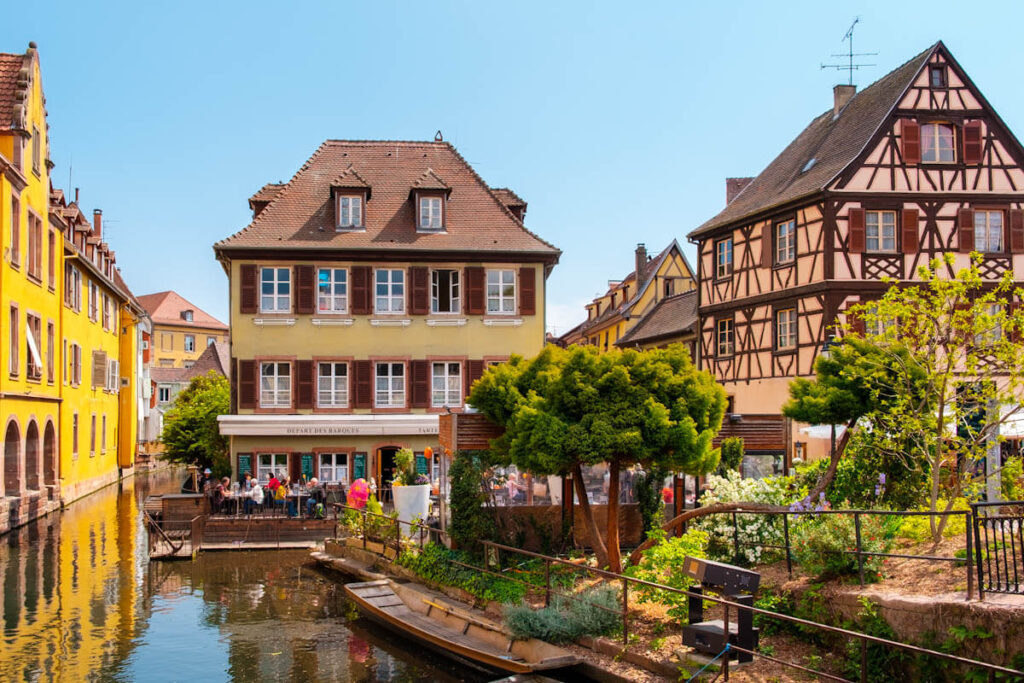
Riquewihr, a fairytale in the wine landscape
Riquewihr is a village that has earned a spot on the Les Plus Beaux Villages de France list. It is perhaps the most famous wine village in Alsace, judging by the many tourists who visit. Riquewihr is filled with stunning half-timbered houses, many of which are painted in beautiful colors. A large part of the city wall is still intact, as well as the city gate.
The main street is very busy, but as soon as you turn into a side street, the crowds seem to disappear. So, here’s a tip when visiting this charming place: make your way quickly through the main street and then take your time exploring the quieter surrounding alleys.
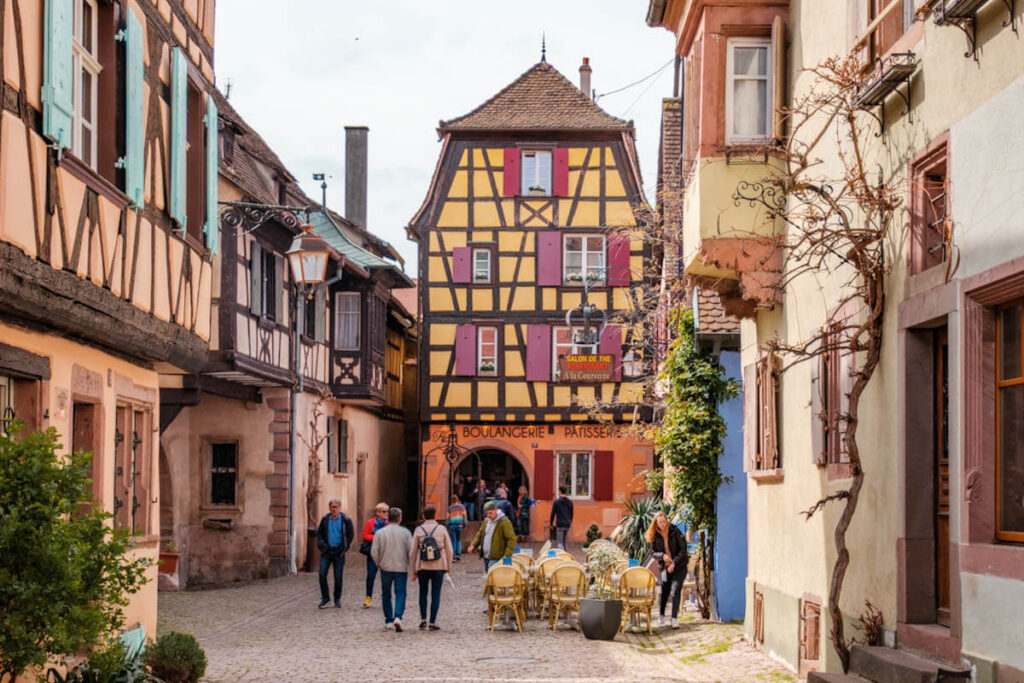
Eguisheim, a village built in circles
Another Les Plus Beaux Villages de France village is Eguisheim. In terms of layout, it might be the most unique. Ring-shaped streets have been built around a centrally located castle, allowing you to literally walk in circles through the village. A fun way to explore is to start with the outer ring, then move one ring inward after completing each loop.
At first, I expected Eguisheim to be less crowded than Riquewihr, but the opposite turned out to be true—it’s just as busy. Still, it’s absolutely worth stopping here during your Grand Est route and spending some time in this charming village. Have lunch on one of the cozy terraces or join a wine tasting. There’s no better way to truly “taste” Alsace!
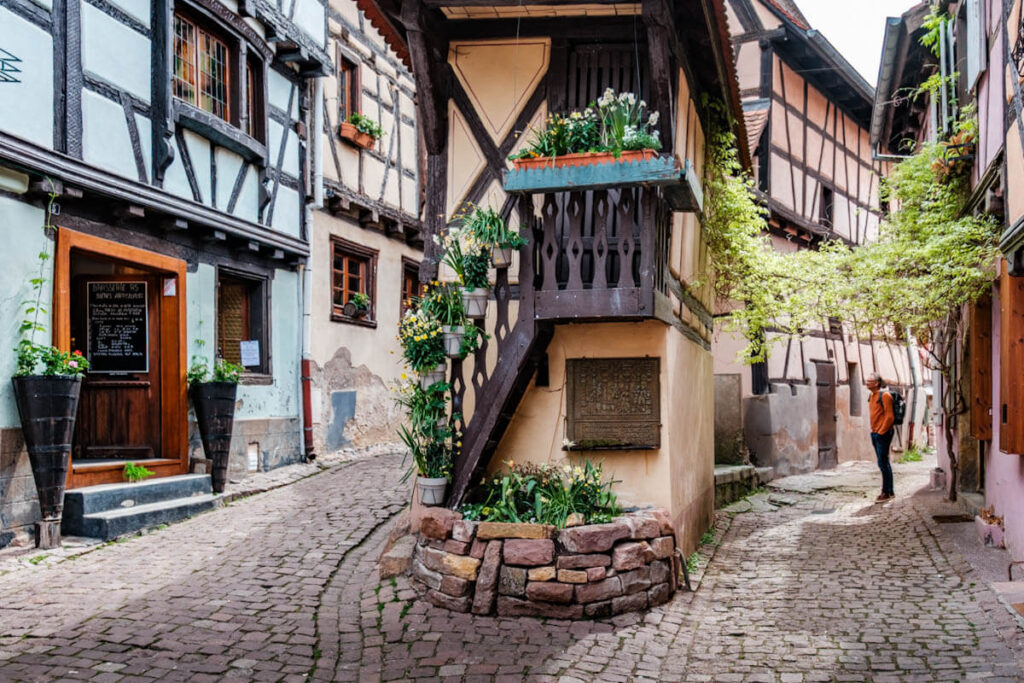
Ribeauvillé, a village full of history and mystery
Ribeauvillé also holds a Les Plus Beaux Villages de France designation. It’s the place I expected the least from, yet it left the biggest impression on me. Ribeauvillé has a stunning historic center with half-timbered houses, narrow streets,and shadowy alleys. Around every corner, a new surprise seems to be waiting.
Ribeauvillé’s history dates back to the 8th century, when it was owned by the bishops of Basel. Over the centuries, its name has changed multiple times; from “Rathaldovilare” shortly after its founding to “Rappotsweiller” in the 19th century.
We stayed for a few nights right in the heart of Ribeauvillé, in a historic building and waking up there was truly special. The town comes alive immediately and in such a medieval setting, there’s always something new to notice. So many details to take in!
Keep in mind that parking at an accommodation in the center can be tricky. If you do find a spot, you’ll often need a parking disc (usually valid for two hours). If no spaces are available, you can park at one of the public parking areas on the outskirts of Ribeauvillé.
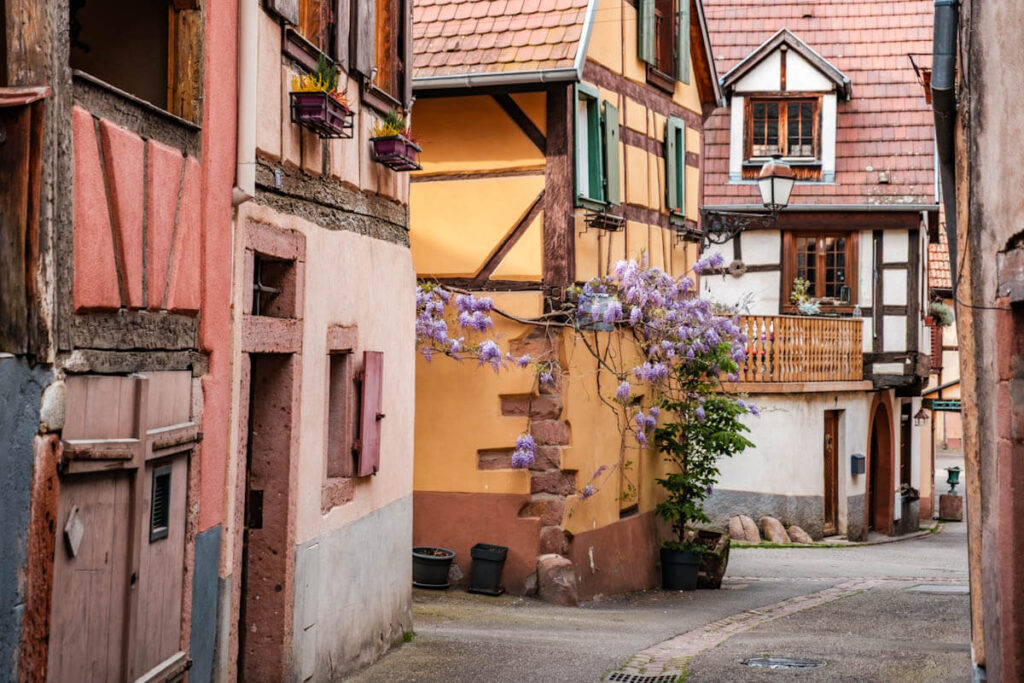
Kaysersberg, colorful half-timbered houses and castles
Kaysersberg is visited less frequently than other wine villages in Alsace. It is the main town of the Kaysersberg-Vignoble municipality, which also includes the former independent communes of Kientzheim and Sigolsheim.
Kaysersberg was once an imperial city within the Holy Roman Empire. Due to its strategic location along one of the mountain passes in the Vosges, it held great importance for a long time. In the early 13th century, Emperor Frederick IIbuilt the castle, which is still known today as Château du Schlossberg. The ruins of this castle can be found on the mountainside. It’s a short climb to the top, but the views along the way make it well worth the effort. From different spots, you get stunning views over the vineyards on the slopes and over Kaysersberg itself, where the bell tower of Église de l′Invention de la Sainte-Croix stands out.
The old town feels like a medieval open-air museum. Beautiful half-timbered houses in every color, cobbled streets and a centuries-old fortified bridge from which you can take in a 360-degree view. The love that Alsace’s residents have for decorating their houses in vibrant colors is once again evident here.
I honestly can’t understand why Kaysersberg hasn’t received the Les Plus Beaux Villages de France label. Perhaps the town is simply too large?
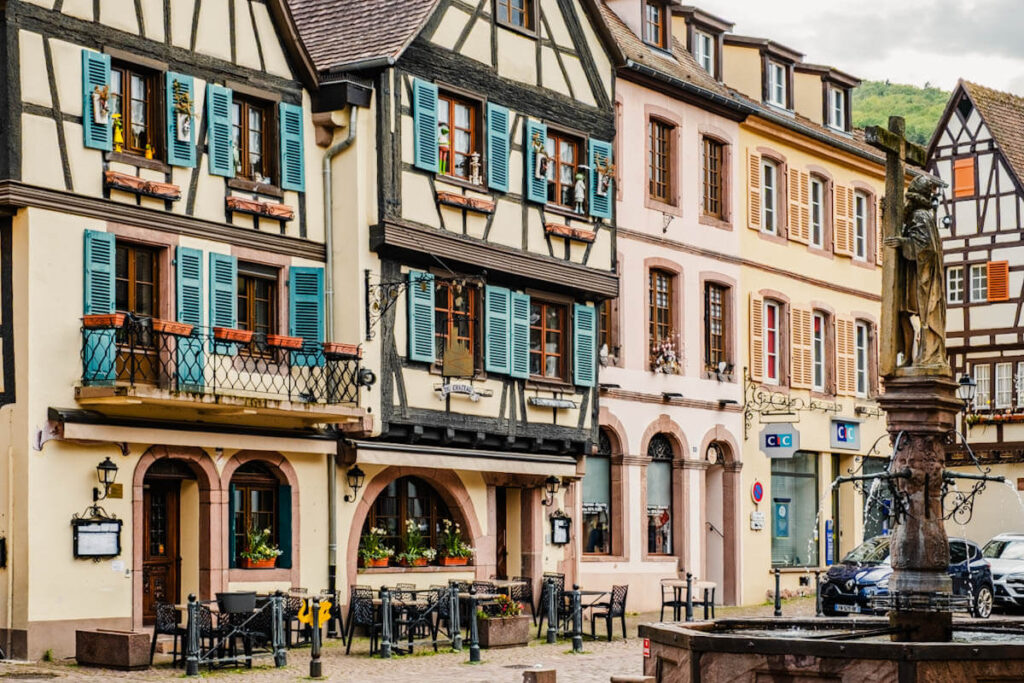
Hunawihr, a hidden gem among the vineyards
Hunawihr is an oasis of tranquility, nestled between Ribeauvillé and Riquewihr. This small, charming wine village is less known among tourists compared to the other villages. The striking church, perched on a hill overlooking the vineyards, dominates the village skyline and gives Hunawihr a fairytale-like appearance. Visiting this village offers the perfect opportunity to escape the hustle and bustle of the larger, more well-known destinations in Alsace. Like several of the villages mentioned above, Hunawihr has also earned a spot on the Les Plus Beaux Villages de France list.
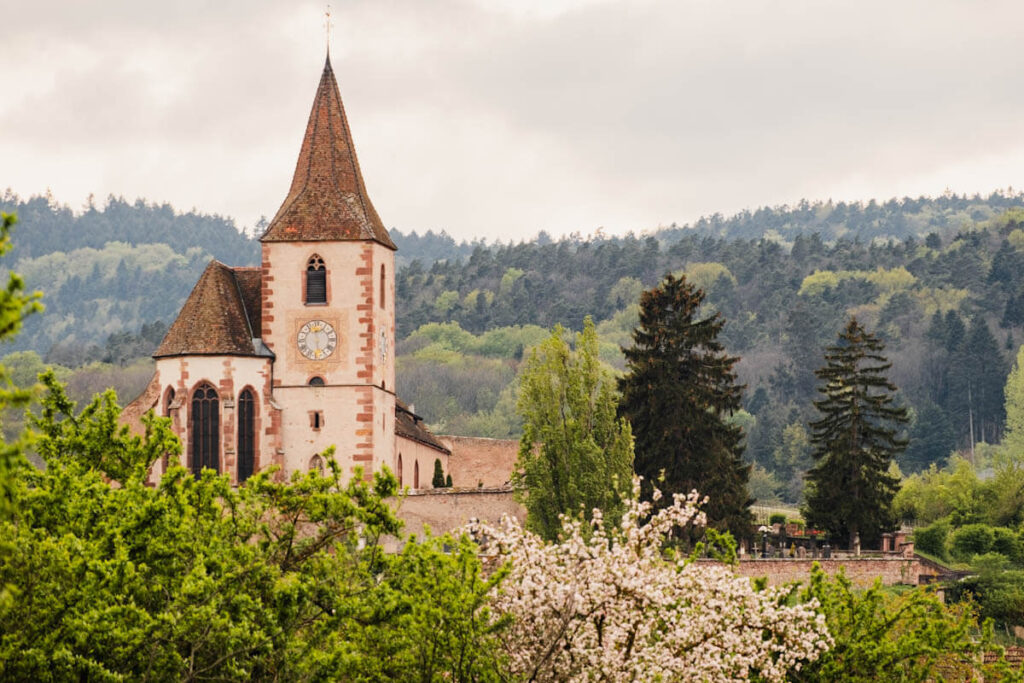
How to get to Alsace?
The distance from Utrecht to Alsace is about 600 kilometers, so you can get there in just a few hours by car. Does that feel too far to drive, especially if you’re only staying for a few nights? Then flying to Strasbourg and renting a car is an easy alternative. In just a few days, you can comfortably explore all the beautiful villages mentioned above.
Prefer not to fly? Taking the train to Strasbourg is another option. However, keep in mind that the journey by train takes about the same amount of time as driving.
Don’t want to explore Alsace on your own? Take a look at this day trip, which takes you to four other wine villages in the region.